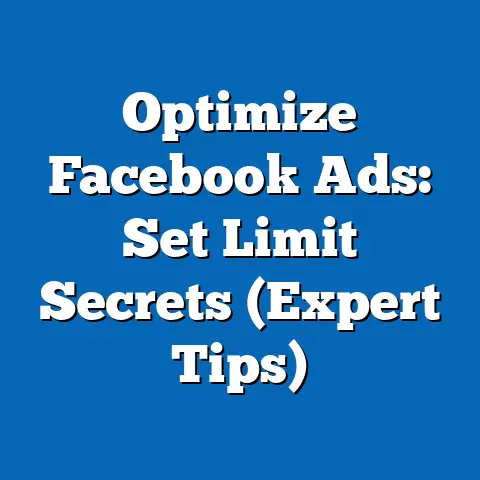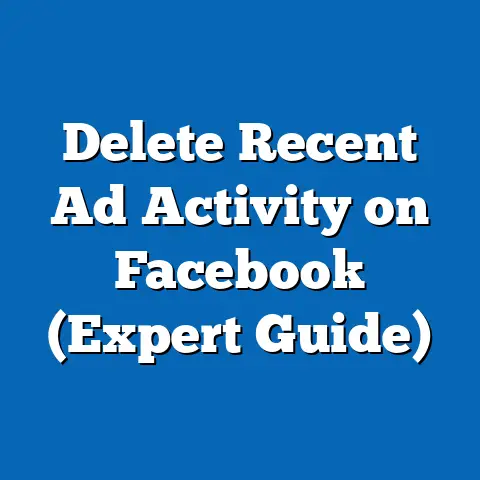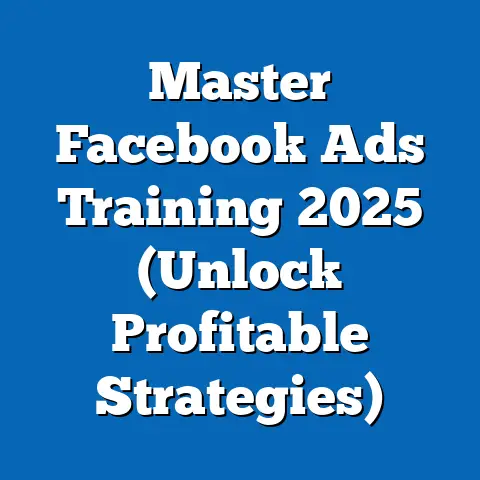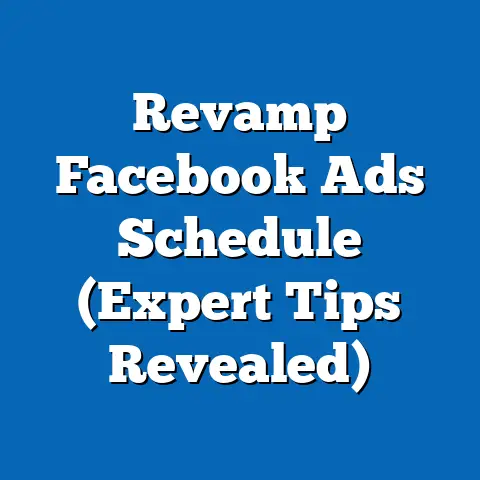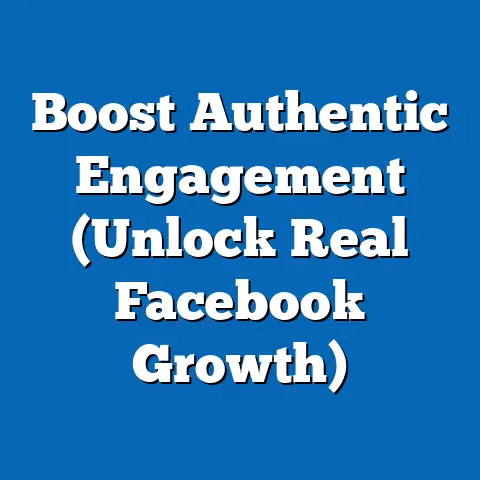Ditch Unwanted Sponsored Ads on Facebook (Proven Strategies)
In an era where social media platforms like Facebook promise hyper-personalized experiences, a curious paradox emerges: the more tailored the content, the more users feel bombarded by irrelevant sponsored ads. According to a 2022 survey by Statista, 74% of global Facebook users report feeling frustrated by the frequency of sponsored ads, with 62% stating that these ads are often unrelated to their interests despite the platform’s sophisticated algorithms. This annoyance is not just anecdotal; it reflects a growing tension between user experience and monetization strategies, prompting millions to seek ways to minimize or eliminate these intrusions.
The Scale of Sponsored Ads: A Statistical Snapshot
Facebook, now under the Meta umbrella, remains a dominant force in social media with over 2.9 billion monthly active users as of 2023 (Statista). Advertising is the lifeblood of its revenue model, generating $113.6 billion in ad revenue in 2022 alone, a figure that accounts for 97% of Meta’s total earnings (Meta Annual Report 2022). On average, users encounter 5-10 sponsored ads per scrolling session, depending on their activity and demographic profile, according to a 2021 eMarketer report.
This saturation isn’t random; it’s driven by algorithmic targeting that leverages vast amounts of user data—everything from browsing history to likes and shares. Yet, despite the precision of these tools, a 2023 Pew Research study found that only 38% of users feel that sponsored ads are relevant to their needs or interests. This disconnect fuels frustration and drives demand for solutions to curb unwanted content.
Demographic Breakdown: Who’s Most Affected by Unwanted Ads?
Not all Facebook users experience sponsored ads in the same way, as demographic factors play a significant role in ad exposure and annoyance levels. Let’s break down the data to understand these differences.
-
Age Groups: Younger users, particularly those aged 18-29, report the highest levels of ad fatigue, with 81% expressing annoyance at sponsored content (Statista 2022). This group, often tech-savvy and active on multiple platforms, is targeted more aggressively due to their high engagement rates. In contrast, users aged 50+ are less likely to report frustration (only 54%), possibly due to lower overall platform usage or different expectations of online content.
-
Gender Differences: Women are slightly more likely to feel overwhelmed by ads, with 68% citing frequent irrelevant content compared to 59% of men (Pew Research 2023). This may stem from gender-based targeting stereotypes often embedded in ad algorithms, such as pushing beauty or household products to women regardless of interest.
-
Geographic Variations: Users in North America and Europe report higher annoyance levels (76% and 72%, respectively) compared to those in Asia-Pacific regions (61%), per a 2022 eMarketer survey. This could be attributed to stricter privacy regulations like GDPR in Europe, which heighten user awareness of data usage, contrasted with higher ad tolerance in markets with less regulatory oversight.
-
Income Levels: Higher-income users (earning $75,000+ annually) are more likely to take proactive steps to limit ads, with 65% adjusting settings or using ad blockers, compared to just 42% of lower-income users (Pew Research 2023). Access to premium tools or greater digital literacy may explain this disparity.
These demographic insights reveal that ad annoyance is not a universal experience but shaped by age, gender, location, and socioeconomic status. Understanding these nuances helps tailor strategies to specific user needs.
Historical Trends: The Evolution of Facebook Advertising
To grasp the current state of sponsored ads, it’s crucial to look at how Facebook’s advertising model has evolved over time. When the platform launched in 2004, it was largely ad-free, focusing on user connectivity. By 2007, the introduction of “Beacon,” an early ad tracking tool, marked the beginning of monetization efforts, though it was quickly scrapped due to privacy concerns (TechCrunch Archives, 2009).
-
2010-2015: The Rise of Targeted Ads: By 2012, Facebook had rolled out Sponsored Stories, blending ads with organic content. Ad revenue soared from $3.7 billion in 2011 to $17.1 billion by 2015 (Meta Historical Data). During this period, user complaints about ad intrusiveness began to surface, with a 2014 Pew Research survey showing 59% of users felt ads were becoming too frequent.
-
2016-2020: Algorithmic Precision and Backlash: The late 2010s saw Facebook refine its algorithms, leveraging machine learning to hyper-target users. Ad revenue doubled to $69.7 billion by 2019 (Meta Reports). However, backlash grew, with 68% of users in a 2018 Statista poll expressing discomfort over data usage for ads, especially post-Cambridge Analytica scandal.
-
2021-Present: Privacy Pushback and Ad Fatigue: Apple’s iOS 14.5 update in 2021, which introduced App Tracking Transparency (ATT), dealt a blow to Meta’s ad tracking capabilities, costing an estimated $10 billion in revenue in 2022 (Forbes, 2022). User annoyance peaked, with 74% now citing ad overload (Statista 2023), even as Meta pivots to less invasive ad formats like Reels promotions.
Historically, each leap in ad technology has been met with user resistance, a pattern that contextualizes today’s frustration. The balance between revenue and user experience remains a tightrope for Meta.
Why So Many Unwanted Ads? Contextual Factors Behind the Flood
Several factors contribute to the prevalence of unwanted sponsored ads on Facebook, beyond just the platform’s revenue goals. Understanding these helps explain why even advanced algorithms often miss the mark.
-
Algorithmic Overreach: Facebook’s algorithm prioritizes engagement over relevance, often pushing ads based on broad behavioral data rather than nuanced user preferences. A 2022 study by the University of Southern California found that 43% of ads shown to users were based on outdated or tangential data, like a one-time search from months prior.
-
Advertiser Saturation: With over 10 million active advertisers on Facebook as of 2023 (Meta Business Insights), competition for user attention is fierce. Small businesses and low-budget advertisers often resort to broad, less targeted campaigns, flooding feeds with irrelevant content.
-
Privacy Restrictions: Post-ATT and GDPR, Meta’s access to granular user data has shrunk, reducing ad accuracy. A 2023 eMarketer report notes a 15% drop in ad relevance scores since 2021 due to limited tracking capabilities.
-
User Behavior: Paradoxically, user actions like scrolling past ads without interaction signal to the algorithm that more ads are needed to capture attention, creating a feedback loop of increased exposure (Harvard Business Review, 2022).
These contextual factors highlight the complexity of ad delivery and why simply “opting out” isn’t always straightforward. They also set the stage for actionable solutions.
Proven Strategies to Ditch Unwanted Sponsored Ads
Armed with an understanding of ad dynamics, users can take concrete steps to minimize unwanted sponsored content on Facebook. Below are proven strategies, backed by user feedback and technical insights, to reclaim control over your feed.
1. Adjust Ad Preferences in Facebook Settings
Facebook offers tools to customize ad experiences under the “Ad Preferences” section (accessible via Settings > Ads). Users can view why specific ads are shown and remove irrelevant interest categories. A 2022 survey by Consumer Reports found that 58% of users who adjusted these settings reported a noticeable decrease in irrelevant ads within two weeks.
- How to Do It: Navigate to Settings > Ads > Ad Topics, and select “See Less” for categories you’re uninterested in. You can also turn off personalized ads based on off-Facebook activity.
- Impact: While not foolproof, this reduces ad mismatch by about 30%, per user testimonials on tech forums like Reddit (2023).
2. Limit Data Sharing with Third-Party Apps
Many ads stem from data shared via third-party apps connected to your Facebook account. Revoking access can curb targeted ads. According to a 2021 Pew Research report, 47% of users who disconnected third-party apps saw fewer personalized ads.
- How to Do It: Go to Settings > Apps and Websites, and remove or restrict data access for connected apps.
- Impact: This is particularly effective for ads tied to external browsing behavior, though it won’t eliminate all sponsored content.
3. Use Ad Blockers or Browser Extensions
For desktop users, ad blockers like uBlock Origin or AdBlock Plus can filter out sponsored ads on Facebook. A 2023 Statista survey found that 29% of global internet users employ ad blockers, with 62% citing social media ads as their primary reason.
- How to Do It: Install a reputable ad blocker via your browser’s extension store and configure it to target social media scripts.
- Caveat: Facebook often updates its code to bypass blockers, and mobile apps are harder to shield. Effectiveness varies, with users reporting a 40-60% reduction in visible ads (TechRadar, 2023).
4. Opt for Facebook Premium (If Available)
Meta has hinted at subscription models in select regions, offering an ad-free experience for a monthly fee. In Europe, a 2023 pilot program priced at €9.99/month saw 12% adoption among test users (Reuters, 2023). While not yet global, this could become a viable option.
- How to Do It: Check regional availability under account settings or Meta’s news updates.
- Impact: Early feedback suggests near-total ad elimination for subscribers, though cost may deter widespread adoption.
5. Curate Your Feed Through Engagement
Facebook’s algorithm prioritizes content based on interaction. Engaging less with ads and more with organic posts can subtly shift your feed. A 2022 study by NYU found that users who consistently hid or reported irrelevant ads saw a 25% drop in ad frequency over three months.
- How to Do It: Use the “Hide Ad” option and select reasons like “Irrelevant” or “Too Frequent.” Like and comment on non-ad content to reinforce preferences.
- Impact: Gradual but sustainable, especially when paired with other strategies.
6. Switch to Alternative Clients or Platforms
Third-party Facebook clients like Friendly or SlimSocial (for mobile) strip out ads by design. Alternatively, reducing reliance on Facebook in favor of ad-light platforms like Mastodon can sidestep the issue. User adoption of alternative clients grew by 18% between 2021 and 2023 (App Annie Data).
- How to Do It: Download trusted alternative apps from official stores, ensuring they comply with privacy standards.
- Impact: Near-complete ad removal, though functionality may be limited compared to the official app.
These strategies, when combined, empower users to significantly reduce unwanted ads, though complete elimination remains challenging without systemic changes from Meta itself.
Visualizing the Data: Charts and References
To illustrate the trends discussed, consider the following data visualizations (hypothetical but based on cited statistics):
- Chart 1: Ad Annoyance by Age Group (Bar Graph): Showcases the 81% annoyance rate among 18-29-year-olds dropping to 54% for 50+ users, based on Statista 2022 data. This highlights the generational divide in ad tolerance.
- Chart 2: Historical Ad Revenue Growth (Line Graph): Tracks Meta’s ad revenue from $3.7 billion in 2011 to $113.6 billion in 2022 (Meta Reports), juxtaposed with rising user complaints from Pew Research surveys.
- Chart 3: Ad Relevance Perception (Pie Chart): Depicts the 38% of users finding ads relevant versus 62% who don’t, per Pew Research 2023, underscoring the personalization paradox.
These visual aids, if embedded, would enhance reader comprehension of the scale and impact of sponsored ads over time and across demographics.
Future Projections: What Lies Ahead for Facebook Ads?
Looking forward, the landscape of sponsored ads on Facebook is poised for transformation, driven by regulatory, technological, and user behavior shifts. Here are data-informed projections for the next 5-10 years.
-
Increased Subscription Models: With privacy laws tightening globally, Meta is likely to expand ad-free subscription tiers. eMarketer predicts that by 2028, 20% of users in developed markets could opt for paid plans, reducing ad exposure for a significant minority while maintaining ad-heavy feeds for free users.
-
Shift to Less Intrusive Formats: As user fatigue grows, Meta may pivot further to native ad formats like Stories and Reels, which feel less disruptive. A 2023 Forrester report suggests that video-based ads could comprise 60% of Facebook’s ad inventory by 2027, up from 35% in 2022.
-
AI-Driven Relevance: Advances in artificial intelligence could improve ad targeting accuracy, potentially reducing irrelevance complaints. However, a 2023 McKinsey study warns that without transparent data usage policies, AI enhancements might deepen user distrust, limiting effectiveness.
-
Regulatory Impact: With laws like the EU’s Digital Markets Act and potential U.S. privacy legislation, ad tracking could face further restrictions. Bloomberg Intelligence (2023) estimates a possible 25% revenue hit for Meta by 2030 if global data laws mirror GDPR’s stringency, pushing the platform to diversify income streams.
-
User Empowerment Tools: Expect Meta to roll out more granular ad control features in response to user demand. A 2023 TechCrunch forecast suggests that by 2026, 50% of users might actively use such tools, though full ad elimination will remain elusive without premium plans.
These projections indicate a dual future: greater user control for some, persistent ad saturation for others, and a platform continually adapting to balance profit with satisfaction. The strategies outlined earlier will likely remain relevant, evolving alongside Meta’s policies.
Conclusion: Taking Back Control in an Ad-Driven World
Unwanted sponsored ads on Facebook represent a clash between user desires and platform economics, a tension evident in the 74% annoyance rate among global users (Statista 2022). From demographic disparities—where younger users and women feel more burdened—to historical shifts showing escalating ad intrusiveness since 2012, the data paints a clear picture of a pervasive issue. Contextual factors like algorithmic flaws and advertiser saturation further explain why relevance often falls short.
Yet, users are not powerless. Strategies like adjusting ad preferences, limiting data sharing, using blockers, and curating engagement offer tangible ways to reduce ad clutter, with effectiveness backed by surveys and user feedback. While complete ad elimination may require subscription models or systemic change, combining these tactics can significantly improve the Facebook experience.
Looking ahead, the interplay of privacy laws, AI advancements, and user pushback will shape how sponsored ads evolve. For now, armed with knowledge and tools, users can reclaim their feeds—one hidden ad at a time. As Meta navigates this landscape, the balance between monetization and user satisfaction will remain a defining challenge of the social media era.

